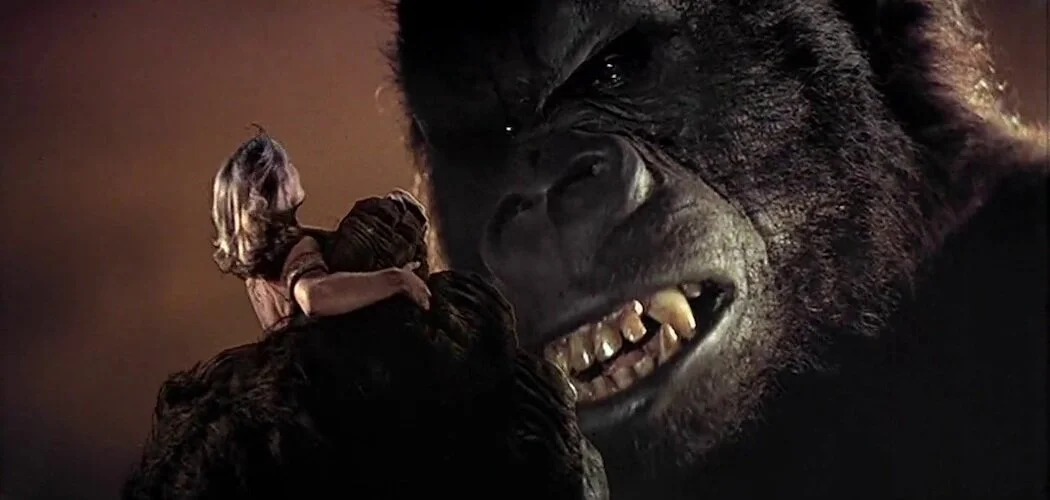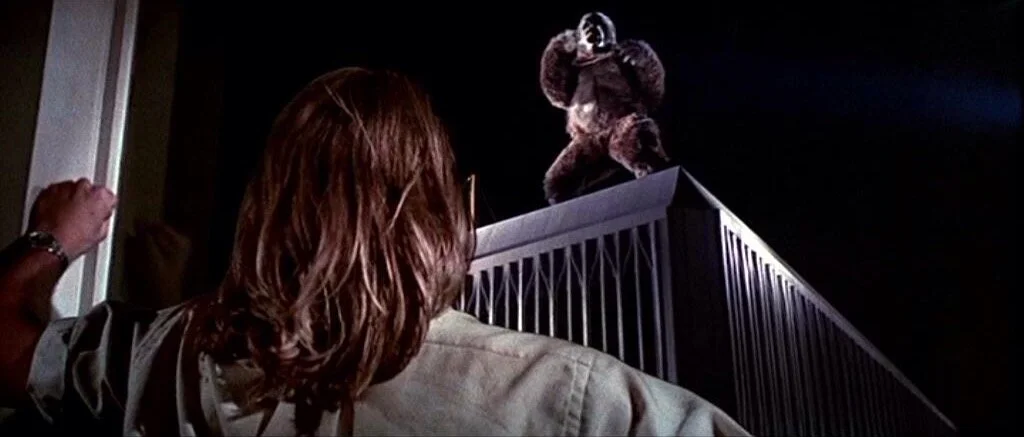KING KONG (1976)
Re-envisioning a Cinematic Legend for the Cynical Seventies
1976’s KING KONG has remained near and dear to me since I first watched it on my parent’s living room 25-inch television. Sadly, I have never actually watched this version of KING KONG in a theater. Regardless, director John Guillermin’s take on the Kong tale captivated and entertained me as a child and teen.
From the time my young eyes took a gander at that gorgeous and striking movie poster featuring the larger-than-life Kong atop of the twin towers of the World Trade Center, with a train in one hand and his beautiful abductee in the other, I knew that this is a movie I had to see. Back then I had no clue that it was actually a remake of a 1933 cinema classic. In fact, I probably was oblivious to the concept of remakes and lacked the cynicism of many film critics at the time when it came to their judgments of this film. All I knew was that this movie looked amazing, powerful, and exciting.
I have no idea how young I actually was when I finally watched it, but it probably was so built up in my mind that I would experience joy and excitement, regardless of the actual quality of the film. Whenever the movie would play on TV, I was there. As I grew older, and became a full-time cinephile, I became a bit more cynical and hypercritical.
After finally watching the 1933 version, I marveled at what the old movie had to offer, and probably felt that the filmmakers who remade the movie in the ‘70s had no right to re-envision what was already a perfectly great classic. Yes—I had become a film snob.
It isn’t exactly a period of which I am particularly proud, but I had developed a bad attitude when it came to remakes or any movie that was inspired by previous films. However, the more titles I watched, and the more my experience with cinema grew, I realized that I had become such a closed-minded fool. I have since rediscovered my love for Guillermin’s remake. I recently revisited the 1933 and 1976 versions for this piece, finding much to love about both.
These rewatches helped me realize that 1976’s KING KONG was such a major part of my cinematic rearing that it actually had a greater impact on my experience than the first movie. As I studied it with wiser, more open-minded eyes, I have concluded that the film is actually a great one of its own accord. And, after further research about its making, I can honestly respect it as an important piece of cinema for its era.
During the 1970s, passionate Italian movie producer Dino De Laurentiis secured the rights of the characters and story for a modern retelling of this grand tale. With an impressive budget and an excitement for the material, De Laurentiis tasked screenwriter Lorenzo Semple and director Guillermin to make Kong feel very real for modern audiences. Using the basic story structure of the 1933 original, but with some relevant changes to the details, 1976’s KING KONG would not only be a massive spectacle but would feature a story intended to touch the hearts of viewers during a time when so many events had hardened such feelings. This was post-Vietnam War and Watergate, and a major oil crisis was then taking place.
Semple kept these real life situations in mind when writing his script and utilizes them well in telling a compelling story surrounding a giant gorilla. The movie begins with Petrox Oil executive Fred S. Wilson (Charles Grodin) embarking on an expensive expedition to a hidden island in the Indian Ocean. He believes he will discover a massive source of oil which will help save his company and expand his own profile.
Paleontologist Jack Prescott (Jeff Bridges) manages to secretly stowaway on board the ship because he already knows that there is more to this island than the greedy Wilson believes. Shortly after making his presence known, the ship comes across an escape raft lost at sea containing a beautiful, unconscious woman named Dwan (Jessica Lange). Dwan, an aspiring actress, has survived an explosion while aboard the yacht of an “interested” movie director.
Dwan and Prescott are both allowed to remain with the crew on the ship as they approach the mysterious, hidden island. Dwan and Jack share an undeniable attraction that’s tested as Jack becomes more critical of Wilson’s motives. They join the crew to explore the island, eventually discovering it is not only the habitat of a group of native people but also the home of a massive gorilla known to the natives as “Kong”.
Watching this movie for the first time in years was an absolute treat. It was, however, bittersweet given that Charles Grodin recently died. In fact, I found it strange that during the time when people were honoring Grodin’s work after his passing, very few mentioned his acting in this film. As I sat through my revisit, I couldn’t help but marvel at his prowess. He is perfectly cast as Fred Wilson, an egomaniacal, but also desperate, company man who desires to achieve massive power and respect within his oil company. It is a character study that marries humor, drama, theatricality, and some cynicism in such wonderful ways.
As Jack Prescott, Jeff Bridges represents the voice of morality and reason. In some ways, the character is similar to Jeff Goldblum’s role as Dr. Ian Malcolm in the JURASSIC PARK films. Bridges brings conviction and passion to a character that is labeled and dismissed as a hippie in the movie. He is an educated man in touch with nature and knows damn well that Wilson’s motives will only serve to harm this world.
Jessica Lange is not only a vision of beauty as Dwan, but she superbly realizes her character. Now granted, her character isn’t a particularly well-written one, and is not exactly an empowering female role that will inspire women. The development of Dwan is a major misstep by the filmmakers, yet Lange gives an earnest and sincere performance that is quite lovable.
With the lead characters in talented and capable hands, there was the huge matter of dealing with the visual effects—particularly in the depiction of Kong himself. Obviously, this was an era when CGI technology wasn’t very robust and the filmmakers had to rely on blue screen backgrounds, matte paintings, models, and a man in well-designed gorilla suit. The design and creation of the eighth wonder of the world would fall upon the shoulders of Carlo Rambaldi and (soon-to-be legendary) make-up artist and creature creator Rick Baker.
With the lead characters in talented and capable hands, there was the huge matter of dealing with the visual effects—particularly in the depiction of Kong himself. Obviously, this was an era when CGI technology wasn’t very robust and the filmmakers had to rely on blue screen backgrounds, matte paintings, models, and a man in well-designed gorilla suit. The design and creation of the eighth wonder of the world would fall upon the shoulders of Carlo Rambaldi and (soon-to-be legendary) make-up artist and creature creator Rick Baker.
Baker would not only help design and build the gorilla suit, but he would don the costume and portray the character.
Baker’s acting, along with some impressive cable work by Rambaldi that gave Kong a wide array of facial expressions, made the titular monster a more realistic character than the stop-motion in its 1933 counterpart. Having a more believable Kong character that can express genuine emotions, makes the creature a more tragic figure—a victim of the folly of humanity. By the time the audience reaches the movie’s iconic climax at the top of the World Trade Center, they have already formed an attachment to the creature and should feel sadness as he falls to his demise.
In the 1933’s KING KONG, character Carl Denham claims that beauty killed the beast; however, in the 1976 version, it is quite clear that the greedy exploits of humanity are responsible for Kong’s death. This much more critical take is a fitting social commentary for an era of government and corporate mistrust—an age where America’s facade of innocence had been completely obliterated.
My article has already gone on way too long, but I’d be remiss if I didn’t also give praise to the skillful direction of John Guillermin, the romantic and sweeping score of John Barry, and the beautiful cinematography by Richard H. Kline. Returning to 1976’s KING KONG for the first time in years was a fun and exciting journey. Watching and analyzing it with adult eyes made me realize that a lot of critics (including myself) wrongly maligned the film for mostly dumb reasons. Granted, a few things do not hold up well—particularly racial and misogynistic overtones. However, the overall experience of Dino De Laurentiis’ vision of King Kong remains thrilling, romantic, and ultimately sentimental.
KING KONG (1976) was recently released on Blu-ray from Scream Factory.








